Fehmarn Sound Bridge
The Fehmarn Sound Bridge (German: Fehmarnsundbrücke) connects the German island of Fehmarn in the Baltic Sea with the German mainland near Großenbrode.[1]
Fehmarn Sound Bridge | |
|---|---|
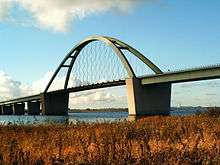 Fehmarn Sound bridge seen from Wulfener Hals | |
| Coordinates | 54°24′05″N 11°06′45″E |
| Crosses | Fehmarn Sound |
| Official name | Fehmarnsundbrücke (in German) |
| Characteristics | |
| Total length | 963 m (3,159 ft 5 in) |
| Width | 21 m (68 ft 11 in) |
| Height | 67 m (219 ft 10 in) |
| Longest span | 248 m (813 ft 8 in) |
| Clearance above | 22 m (72 ft) |
| History | |
| Opened | 1963-04-30 |
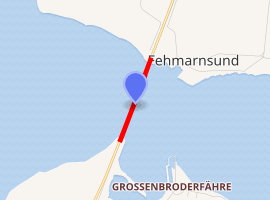
| |
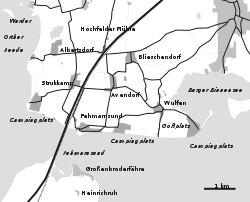
Description
The 963-metre-long (3,159 ft) crossing includes the 248-metre-long (814 ft) network arch bridge which carries road and rail over the 1,300-metre-wide (4,265 ft) Fehmarn Sound. Construction began in 1958 and the bridge was opened on April 30, 1963. The main span is 22 metres (72 ft) above the sea, which allows shipping to pass through. The bridge is constructed of steel and is 21 metres (70 ft) wide; 6 metres (20 ft) are used by Deutsche Bahn for a single rail track, part of the Lübeck–Puttgarden railway, the rest for a pedestrian walkway and two-lane roadway. The two steel arches, from which the central span is suspended by cables, are braced with steel cross-beams. The arches are 248 metres (810 ft) in length and reach 45 metres (150 ft) above the main deck of the bridge. The bridge was designed by engineers G. Fischer, T. Jahnke und P. Stein from the firm Gutehoffnungshütte Sterkrade AG, Oberhausen-Sterkrade. Architect Gerd Lohmer helped with the architectural design.

Route and ferry changes
At the same time as the opening of the bridge, changes were made to ferry services. The previous ferry service to the island of Fehmarn was discontinued. The service from Großenbrode Quay, Germany to Gedser, Denmark, crossing both Fehmarn Sound and the Fehmarn Belt, was replaced with a new service from Puttgarden (on Fehmarn) to Rødby, Denmark crossing just the Fehmarn Belt. The new bridge and ferry changes brought about a substantial time saving for both road and rail traffic along the so-called Vogelfluglinie (literally "bird flight line") from Hamburg to Copenhagen.
Historic monument
The Fehmarn Sound bridge was declared an historic monument in 1999 by the State Office for Protection of Historical Monuments of Schleswig-Holstein in Kiel, and has since become a symbol of both Fehmarn and Schleswig-Holstein.
Cold War explosive charges
As the bridge was built during the Cold War, six explosive vaults were embedded below the approach road on the mainland side to be used in case of invasion. Their location is given away even today by six square asphalt patches. The vaults were connected to a control point about 1 km (0.6 mi) away in Heinrichsruh.
- Fehmarn Sound bridge viewed from the west
- Fehmarn Sound bridge viewed from land (from south)
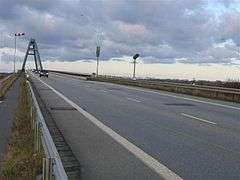 6 asphalt patches over former explosive charge vaults
6 asphalt patches over former explosive charge vaults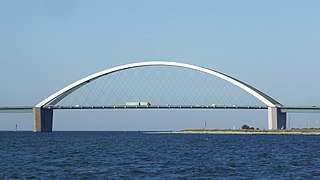 Fehmarn Sound bridge seen from east
Fehmarn Sound bridge seen from east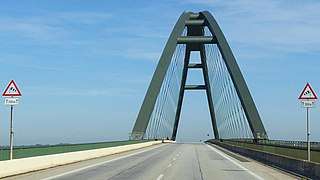 Fehmarn sound bridge seen from south. In use as a road bridge, rail bridge and with bike path
Fehmarn sound bridge seen from south. In use as a road bridge, rail bridge and with bike path
Future
A Fehmarn Belt Tunnel is decided, between Denmark and Germany, with four lanes (2+2) and double track railway.[2] But according to the agreement between the two countries, the Fehmarn Sound bridge can remain as it is, one lane per direction and a single railway track.[3]
In december 2012 a study was published saying that the bridge could not cope with the increased railway traffic expected after the tunnel opening.[4]
It has been considered to build a replacement, or to keep the bridge for road traffic and build a rail connection, maybe a Fehmarn Sound tunnel. The state as historic monument has to be considered.
References
- Platzöder, Renate; Verlaan, Philomène A. (1996). The Baltic Sea: New Developments in National Policies and International Cooperation. p. 147. ISBN 9041103570.
- "Railway Gazette: Fehmarn Belt tunnel preferred". Retrieved 2011-01-02.
- Aftalememorandum af 29. juni 2007 (in Danish).
- Curd Tönnemann (2012-12-21). "Gutachten: Fehmarnsundbrücke nicht belastbar genug". Lübecker Nachrichten. Retrieved 2012-12-21.
- Meier, Günter (1988). Die Vogelfluglinie und ihre Schiffe (in German). Herford: Koehler. ISBN 3-7822-0441-7. OCLC 74958103.
- Ernst, Friedhelm; Meier, Günter (1999). Die "Vogelfluglinie" : die Eisenbahnfähren, die Fehmarnsundbrücke, neue Verkehrsströme nach der Wende, die neuen "Doppelendfähren" (in German). Freiburg (Breisgau): EK-Verlag. OCLC 76062078. Originally published in EISENBAHN-Kurier SPECIAL 53, Freiburg 1997.
- "Fehmarnsundbrücke bei Burg auf Fehmarn" (in German). Hamburg University of Technology. Archived from the original on 2007-10-20. Retrieved 2008-01-28.
External links
| Wikimedia Commons has media related to Fehmarn Sound Bridge. |
- Pictures of the construction and opening of the bridge (in German)
- Video of the construction of the bridge (in German)